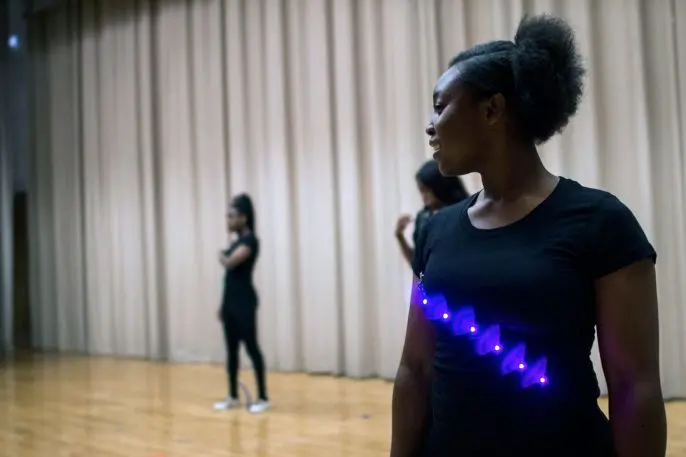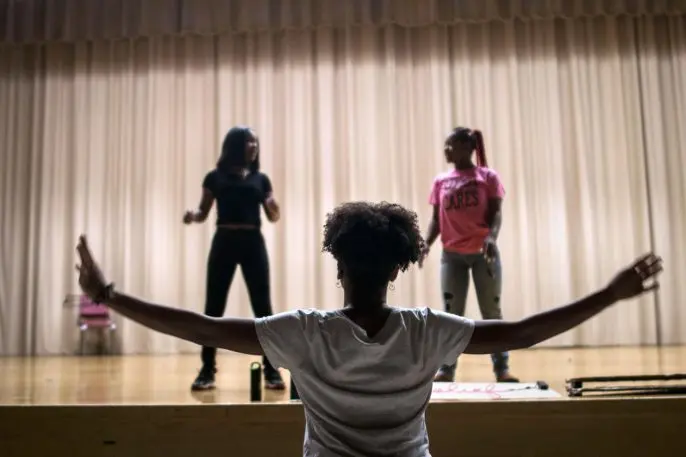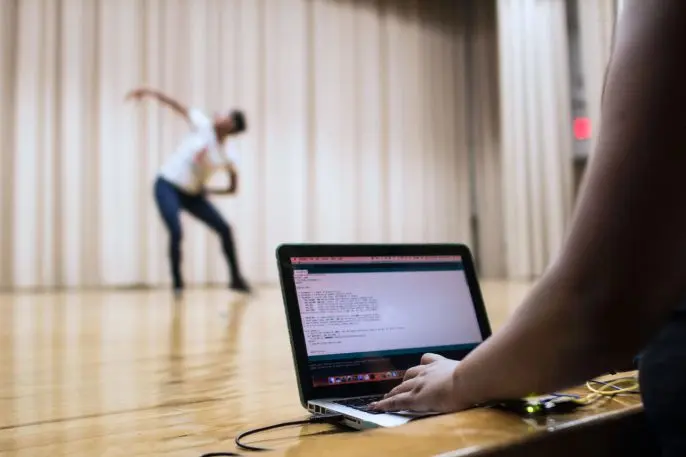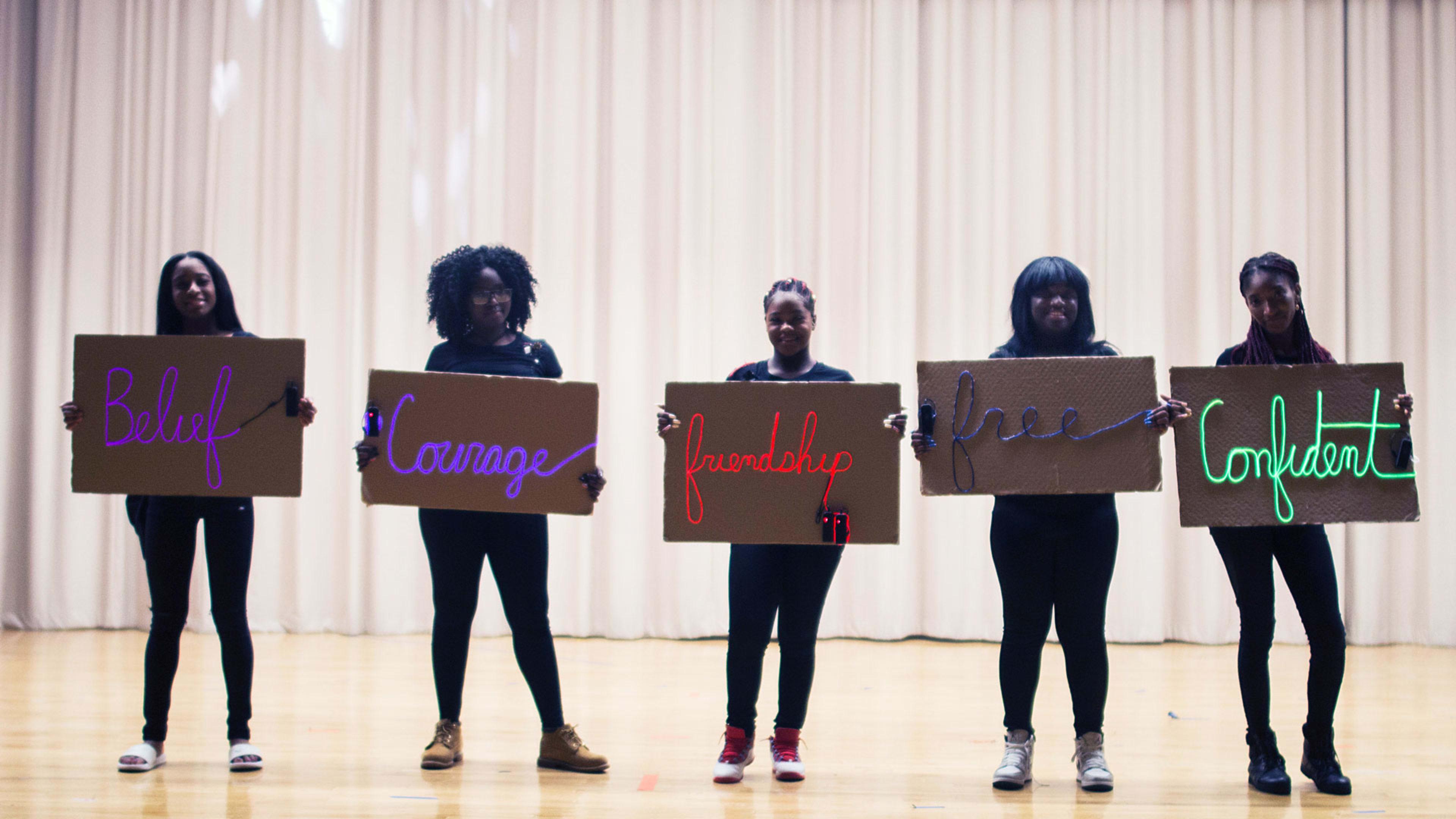On a Monday afternoon, in a cluttered classroom in Harlem–alongside messy paper-strewn desks, half-dead plants, and Costco-size boxes of Pirate’s Booty–a group of about a dozen 8- to 12-year-old girls take center stage. In matching blue T-shirts, they form a circle, moving slowly in a game that resembles a modern version of Duck, Duck, Goose.
“On circuit,” commands the instructor, as the girls shuffle forward. She then quickly asserts a stop: “Off circuit.”
The girls, awaiting the next command, stand at attention.
“When we’re the circuit, we’re going to be moving in a circle, mimicking electricity,” explains the instructor. “Now let’s make our electrons move.”
This is the warm-up exercise at STEM From Dance, a nonprofit organization that uses movement to teach girls the tenets of science, technology, engineering, and mathematics. Here, young women from lower-income communities are given the tools to embrace what are often considered trickier subjects with something they know and love: dance. They learn to code media that syncs up with choreography to songs by popular female artists like Rihanna and Beyoncé.
Throughout this two-hour session, the girls will eventually move their way through a choreographed routine with the help of neon color-coded electronic wristbands. It looks like TRON, if the movie was set at an ’80s nightclub. As Sophia Grace’s “Girl in the Mirror” plays in the background, the few assembled sashay and move their hips. There’s palpable swagger in the room, as each participant throws her hand in the air as the splashy wearables light on and off.

Founder Yamilée Toussaint, who began STEM From Dance in 2011, concedes that to some degree, the organization is leveraging the popularity of modern dance to lure girls into more male-dominated subjects. But after several weeks, she reports the girls find themselves equally interested in both.
“[The students] will say, ‘You know, initially I thought this was going to be boring and I really just wanted to dance, but this is actually pretty cool, and this is something that I would be interested in doing in college as well,'” says Toussaint.
Overcoming “Bad Experiences”
Yamilée Toussaint, 30, grew up on Long Island surrounded by enthusiasm for math and science. Her mother worked as hospital technician. Her father, an immigrant from Haiti, often couldn’t stop talking about his love of engineering.
“We’d be eating dinner at home, and he’d speak about his job with so much enthusiasm,” recalls Toussaint. “It was clearly something he enjoyed.”
That enthusiasm rubbed off on young Yamilée and her brother, who both pursued careers in mechanical engineering. She had also been dancing since was 4–even professionally–but leaned toward engineering when she was accepted into the Massachusetts Institute of Technology.

Toussaint was struck by the blatant lack of diversity at the prestigious university. There were roughly less than 20 black women studying at the school, with barely many more Hispanic or African-Americans as a whole. “That made me a little sad,” she says.
After graduating, Toussaint felt determined to close the gap between math and minorities. It felt especially poignant when she learned that the U.S. Bureau of Statistics estimates that 80% of future careers will in some way rely on STEM skills. Meanwhile, only 2% of the current workforce in STEM industries are black or Hispanic, according to the U.S. Department of Commerce.
Toussaint enlisted in Teach for America, where she taught math in the low-income community of East New York in Brooklyn. The young educator wanted to know what impact she could have by providing an enthusiastic approach to math education. She also wanted to see firsthand what young students struggle with.
She was met with what she calls a “tough” but valuable learning experience while teaching ninth-grade algebra. The majority of her students were jaded by “bad experiences” during elementary and middle school, and resigned to the idea they didn’t have the talent to fully understand the subject.
“They were convinced that math wasn’t ‘their thing,'” says Toussaint, who found it to be an outrageous statement. “At this point in society, you can’t just get away with saying [math] isn’t ‘your thing.’ That’s like saying, ‘Reading isn’t my thing.'”
But the challenge still existed: “How do you change somebody’s mind-set about something?”

Building Up Confidence
In all stages of Toussaint’s life, dance played an integral role. She participated in dance recitals as a child, and had trained professionally throughout high school and college. But upon embarking on a career, she wondered how to best integrate it into her life. When she finished the program at Teach for America in 2010, she realized she had three subjects she was equally passionate about: math, dance, and education.
“They all seemed so random,” says Toussaint, “but they were all things that I love.” She didn’t want to forsake any of them, which led her to think: What if I combined all three?
In 2011, Toussaint convinced the principal of a school she previously taught at to let her try out an idea. It would be an after-school program for girls in which the first half would be committed to dance, and the second half to math tutoring. The feedback she received after several sessions, however, was that it felt “too disjointed.” She needed to make the subjects coexist in a cohesive, playful manner.

While discussing her goals with fellow MIT peers, Toussaint learned about a web platform in which one could code and design moveable graphics. It sparked a realization: Students could code much like how they choreographed dance routines. They’d code these lively images to complement their steps.
Toussaint designed a new program, called STEM From Dance, in which students would create dance performances that incorporated coded wearable technology as well as coded imagery that would dictate their moves. Led by a team of math and dance professionals, they’d learn about coding, design, circuitry, and physics, all while often using the same planning and problem solving used for dance. Each performance was then set to an inspirational song by a female artist, be it Daya, Beyoncé, or Mary J. Blige. The groups of around a dozen girls met twice a week for two to three months, with a public recital at the very end.
The program took off, with numerous girls in middle school and high school intrigued by the idea of putting on their own dance routine–with the aid of modern technology. Sessions began to fill up, and additional schools requested that Toussaint visit their classrooms.
“The students have really been enjoying it,” says Toussaint, “especially the opportunity to create something. It’s powerful to give them a blank page and empower them to fill it themselves.”

STEM From Dance now partners with eight schools in New York, which provide the space and laptops. Toussaint provides the instructors and logistics, which is 60% funded by foundation grants (schools pay a fee in participation with the Department of Education). Moving forward, the goal is to spread the program to more cities nationwide by establishing a curriculum that after-school programs can execute on their own.
Toussaint is raising a new generation that, despite former “bad experiences,” believe they have a future in math and science. Several students are already applying for STEM scholarships and considering colleges based on the subjects.
“They have different perceptions about STEM now,” says Toussaint. “More and more, they see people like them can have STEM careers. Originally they thought [it was] just men or white people. They are starting to see that it can be a black or Hispanic woman.”
Recognize your brand’s excellence by applying to this year’s Brands That Matter Awards before the early-rate deadline, May 3.
